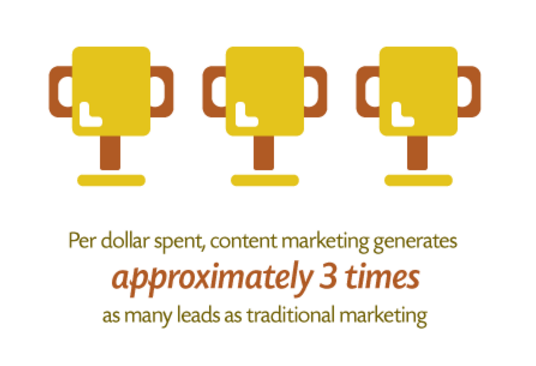Regardless of your industry, most of us in marketing and sales understand that the Internet is one of the best places to connect with new customers.
But what most marketing and sales professionals don’t understand is how to cost-effectively and consistently capture leads from the Internet. And for good reason; with social media, email marketing, SEO, blogging, etc. it's a jungle out there.
So how does one successfully build cost-effective and consistent lead generation from the Internet? Through Content Marketing.
What is Content Marketing?
This is by far one of my favorite definitions for Content Marketing from Convince and Convert:
"Content marketing is a device used by companies to educate, inform or entertain customers or prospects by creating attention or causing behavior that results in leads, sales or advocacy."
The basic idea of Content Marketing is for your company to put out content that connects with your target customer and encourages your target customer to come to you to consume the content.
Content Marketing is all about providing value via content to strangers to your brand so they can get some awareness about your brand. This type of marketing is also referred to as “Demand Generated” or “Pull” marketing, where people come to you, instead of you going to them with annoying advertisements.
What are examples of valuable content that attracts strangers to your brand?
- It could be a PDF checklist of considerations for first-time homebuyers.
- It could be a blog post about understanding what affects interest rates and pricing/points for loan programs.
- It could be a PDF guide that gives a good overview of all the schools, restaurants, and activities in your local community.
- Or it could be a video talking about the latest Fed decision and how that might impact interest rates in the short term.
Anything can be content, but the idea here is to provide relevant, engaging and useful content to strangers so that they come to you (as opposed to you going to them).

We’ve worked with retail Mortgage Bankers with various business models (i.e. traditional distributed branch retail, call center) and have found that many mortgage companies are not taking advantage of the enormous opportunity to connect with more customers online via Content Marketing.
If you’re a mortgage company that wants to start organically generating more leads online, read on to understand why Content Marketing needs to be an important component of your marketing and lead generation strategy.
It Encourages Inbound Lead Generation
Inbound (or demand generated) leads typically convert at a much higher rate than Outbound leads.
With Outbound, your team is focused on looking for new customers by contacting them and trying to convince them to buy your product. Cold calling and direct mail are examples of Outbound methods to generate leads.
With Inbound, you are trying to find ways to make your customers want to find you and learn more about you. Blogging, SEO, and social media are all examples of tools/techniques that can be used to encourage Inbound lead generation.
So why do Inbound leads typically convert at a much higher rate than Outbound leads? Let’s say that your mortgage company decided to buy a list of phone numbers to cold-call for potential purchase opportunities.

Generally speaking, the potential borrower is not going to be expecting your phone call (if your phone call gets through at all). Additionally, that borrower is probably getting bombarded with calls from other MLOs who have the same exact list.
Compare this to a customer who searches “first-time homebuyer’s guide for Irvine” and your mortgage company provides a PDF document on the subject. You can set this PDF document up to be accessed, if and only if, the customer provides their name and email address in exchange for the document. You now have an inbound lead who has signified to you two things:
- They’re potentially a first-time homebuyers
- They’re interested in a property in Irvine, CA
This gives your MLOs a little bit more context on this potential borrower when they reach out to him/her.
It also gives your MLO a “softer” intro to the potential borrower because they’ve seen your company’s brand and voluntarily downloaded your content.
Compare this to a cold call, where the borrower may have never heard of your company and was not expecting a phone call. Which lead do you think will convert at a higher rate?
Inbound leads are the gold standard for lead generation and adopting a mortgage-specific content marketing strategy can help you build an inbound lead funnel.
It's A Great Way to Connect with Millennials
We keep talking about how important the millennial generation is to the real estate and mortgage industries. Now, many of this generation have the earning power to buy homes.
So why do mortgage companies keep using traditional advertising methods to try to capture them as leads?
Traditional marketing (TV ads, radio ads, direct mail, cold calling, etc) have become woefully ineffective with millennials because they inherently distrust outbound, company-focused advertising. Here’s a great anecdote from the Huffington Post that illustrates my point:
"I honestly can’t recall the last time I bought something based off a television commercial.
I can’t recall the last time a billboard had a lasting impression on me.
In 20 years of using the Internet, I don’t think I’ve ever clicked on a banner ad.
In my house, sales papers go to either the trash or the fireplace.
Right now, as I write this, Spotify just interrupted my playlist of instrumental concentration music to play an ad, and I have no idea what that ad was about.
Traditional advertising literally has no effect on me. It doesn’t influence my buying habits whatsoever. In fact, I feel comfortable saying that I’m completely immune to it. And if you’re a millennial like me, there’s a good chance you’re immune to it as well.
Here’s why: Millennials don’t trust advertisements."
The point I’m trying to make here is that if you want to connect with more Millennials, you need to start setting up a marketing strategy that connects with them.
Instead of using traditional, outbound, advertising, you need to start developing useful blog posts and guides which attract Millennial borrowers to your website or landing pages.
This all starts with developing content that is authentic, useful, and provides value to them.
A great analogy I like to use is to think of content and a borrower’s lead information as currency.
In order for the borrower to give up their lead information to you, something valuable needs to be provided to them.
Adopting a marketing strategy that keeps this philosophy in mind will be important to connecting with Millennial buyers online.
It Helps Your MLOs Close More Internet Leads
I’ve had experience working with Internet leads and it's safe to say that leads gathered from the Internet wildly vary in quality.
Purchased Internet leads are typically the lowest converting because many of those leads are also shared with other lenders.
Inbound leads from rate table sites like Informa and Bankrate have much better quality, but the cost to advertise on these sites can be prohibitive.
So either you’re getting stuck with crappy leads for a low price, or better leads at an expensive price.
What if you could generate your own leads through a Content Marketing strategy that were higher quality leads at a lower price?
That’s exactly what you’re doing in creating content that attracts inbound leads. As you publish more relevant and useful content, your company will be seen as an “authority” with search engines and you’ll also start to gain more brand equity on social media.
Then as people on the Internet continue to do research and find your content, you’ll continue to generate more inbound leads with your content.
It's also important to note that this is going to make your loan officers a lot more efficient in closing Internet Leads.
Why?
It's because the leads that you generate through Content Marketing are leads that have volunteered their information to you.
This means that they’ve indicated that their interested in your product/service, which gives the loan officer a warmer introduction to the customer. And because you’ve already provided value to the customer through your content, your loan officer is getting in contact with your customer at a time when you’ve got some pretty decent brand equity with that customer (as opposed to harassing them with a phone call).
Think about that for a second.
Which becomes a lead that the MLO has a better chance to get an application form? The one that you provided useful content to? Or the one that you cold-called? I’ll give you two guesses, but you probably only need one.
Are you a mortgage banker that is using content marketing to drive inbound leads? What types of content are you creating? Have you been successful at your lead generation efforts? I’d love to hear some of the strategies that you’re currently using!
.png)

-1.png)
.png)